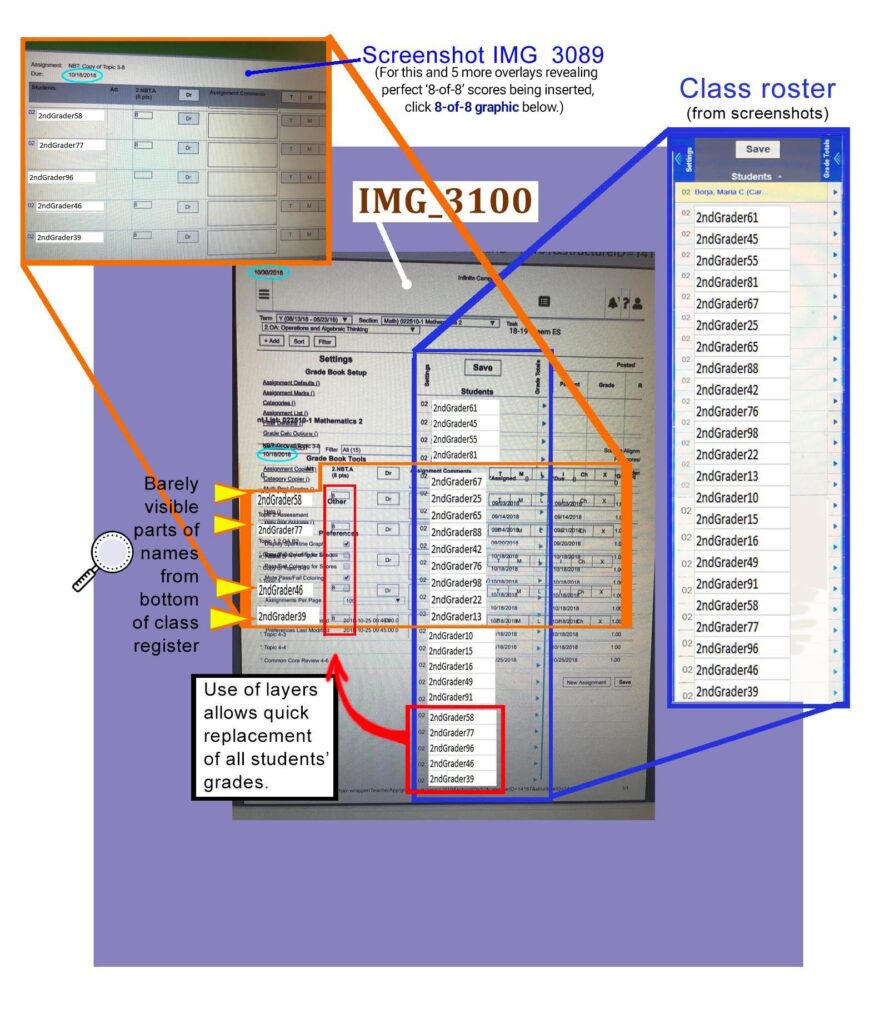
This graphic shows how CCSD’s version of the Infinite Campus grading software-ensemble allows largely transparent layers with false grades to be created and placed on top of blank, base layers, and then saved. It’s a way of mass-producing changes in student grades for report cards.
It is not yet clear whether this capacity is built entirely into the native Infinite Campus software or exists within the third-party modules that can be imported into that software during the report-card preparation process. At least two different companies advertising on the Web make modules that appear to help facilitate this type of grade falsification.
At the top left of the exploded view is IMG_3089, one of six similar screenshots showing overlays made to mass-falsify test grades for all second-grade students in this class. (Several had been transferred out by their parents by the date of this particular falsification.) Below is a graphic which, clicked on, will download a PDF containing screenshots of overlays made to facilitate the mass change of grades for the entire class.
If you examine these screenshots, you’ll notice the words: “NBT: Copy of Topic 3-8” at the top of each of the six pages in the PDF. “NBT” is Common-Core speak for “Number & Operations in Base Ten,” the second math category that second graders at CCSD are supposed to master.
“Copy of Topic 3-8” refers to a page in the school’s area of the Infinite Campus cloud that was copied and “edited” to give the kids perfect 8-out-of-a-possible-8 scores.
A similar process was followed to falsify test scores in the case of “NBT: Copy of Copy of Topic 3-9,” below. (Click here to pull up its PDF.) In this case, it was only a four-question test, but once again the created overlays report that all the kids supposedly achieved perfect 4-out-of-the-4-possible scores. Once again, the manipulations are dated 10/18/2018.

Both these sets of PDFs show screenshots of overlays crafted to change assessments under the “2.NBT.A” heading. Interestingly, Oliver says most second graders find the NBT assessment tests more difficult than the first set of common-core math assessments confronting them at the start of the school year, headed “2.OA,” (a term that stands for “Operations and Algebraic Thinking”). Thus, he says, second-graders’ scores on the NBT assessments usually fall below the scores they’ve already received on the OA tests. However, at Treem, these second graders had so badly failed the OA.A, OA.B, and OA.C assessments that CCSD’s no-grade-lower-than-an-F policy kicked in — raising those scores to F’s. Consequently, when Treem administrators later used their layer-manipulating capability to deceptively report perfect NBT scores for every child to those children’s parents, no such fall was reported.


